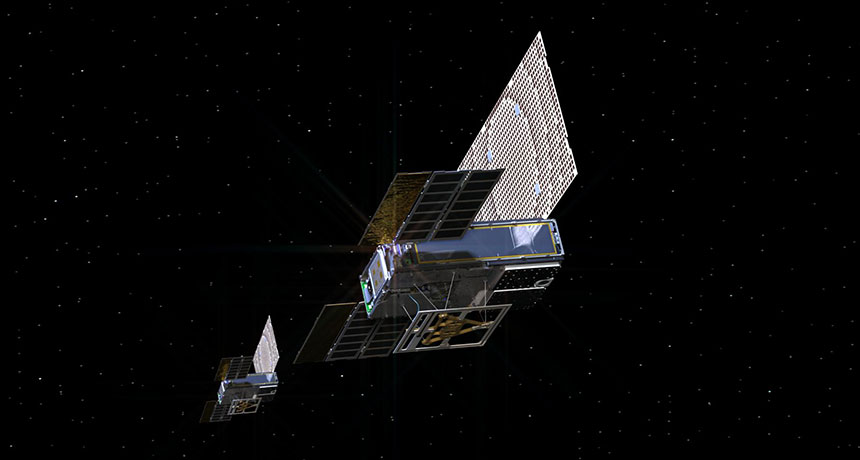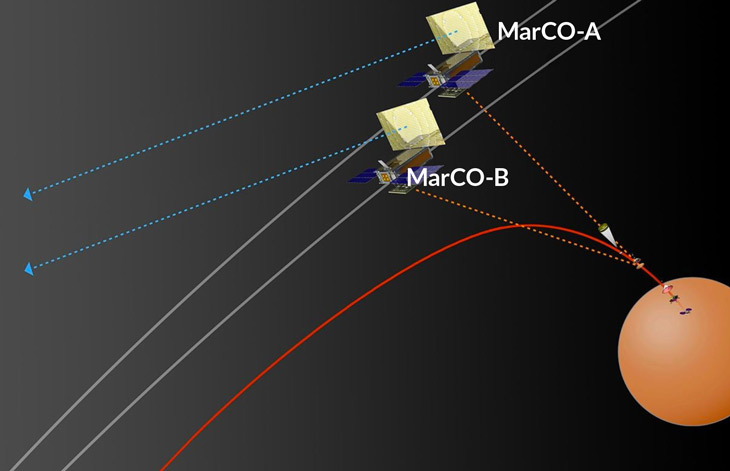Tiny satellites will relay news of InSight’s Mars landing in minutes, not hours
Two CubeSats will send data back to Earth of the lander’s fate as they pass the Red Planet

BOLDLY GOING Two briefcase-sized satellites, shown side by side in this artist’s rendering, will become the first tiny spacecraft to fly by Mars and act as communications relays for a lander.
JPL-Caltech/NASA
- More than 2 years ago
The next spacecraft set to land on Mars is bringing its own communications team. InSight, a lander scheduled to touch down on the Red Planet on November 26, is accompanied by a pair of briefcase-sized spacecraft that will send details of the landing to Earth in almost real time.
The twin craft on this mission are CubeSats — tiny, inexpensive satellites that are easy to build and launch. Called Mars Cube One, or MarCO for short, they will fly past Mars as InSight lands, becoming the smallest spacecraft ever to be entrusted with a task as crucial as relaying landing information for a mission. Now nearing Mars, they are also already the first CubeSats to make it so far from Earth. If all goes well with InSight’s landing, future Mars missions could also be equipped with their own single-use comms team.
“A future where landers and rovers brought their own communications systems for landing, that would be fantastic,” says engineer Joel Krajewski of NASA’s Jet Propulsion Laboratory in Pasadena, Calif., and MarCO’s program manager.
InSight — short for Interior Exploration using Seismic Investigations, Geodesy and Heat Transport — will carry the first seismometer to Mars (SN: 5/26/18, p. 13). After touching down in a wide, flat plain called Elysium Planitia near Mars’ equator, the lander will sit perfectly still to listen to seismic waves and measure how heat flows through the Red Planet’s interior. The results will help scientists understand how Mars, and perhaps other rocky planets like Earth, formed around 4.5 billion years ago.
It will be only 6½ minutes between when InSight enters the Martian atmosphere, at a speed of nearly 1,000 meters per second, to the moment its legs touch the ground. The spacecraft will use a parachute and rockets aimed at the ground to slow to about 2.4 meters per second as it lands. Light-speed signals from the CubeSats or Insight itself will then take about eight minutes to travel between Earth and Mars, so by the time NASA engineers hear that InSight has entered Mars’ atmosphere, the spacecraft will be on the ground.
“Which is terrifying,” says engineer Farah Alibay, also of the Jet Propulsion Laboratory. “Whether it landed softly or pretty hard, we won’t know. But we’ll know when you get that first bit of data, InSight’s already landed.”
We’re listening
The MarCO CubeSats will watch InSight’s descent to the Martian surface (red line) and send details of the landing back to Earth, before continuing past the planet.

For most previous Mars landings, one of the large orbiters currently circling the Red Planet had to pause its data-taking to watch the event and send details to Earth. The orbiter that will be in the best position to watch InSight will be NASA’s Mars Reconnaissance Orbiter. While that spacecraft will observe the landing, it won’t be able to relay any details to Earth for at least three hours as its orbit takes the craft behind Mars from Earth’s point of view, blocking communications.
“Three to four hours is not long for most people, but it’s pretty long for us,” Alibay says. “Landing is the scariest part of your mission.” Waiting to hear about the spacecraft’s landing is like waiting for news about a loved one’s health, she says.
To avoid that waiting, the team sent the twin CubeSats. The spacecraft launched with InSight, but have been navigating through deep space on their own since May. The MarCO craft can change their trajectories by expelling compressed cold gas, similar to the way a fire extinguisher works — which earned them the nicknames Wall-E and Eve among the team, after the space-flying Disney robot characters. “We’ve demonstrated that a CubeSat can leave Earth orbit, survive the harsh environment of space and direct itself towards Mars,” Alibay says.
About five minutes before InSight hits the top of the Martian atmosphere, the two MarCO craft will position themselves to track the lander all the way to the ground, and send details back to Earth immediately. Each operates independently, backing each other up.
If all goes well, MarCO could set a precedent for future Mars missions. Existing Mars orbiters will be able to support two Mars missions launching in 2020 — NASA’s Mars 2020 rover and the ExoMars rover run by the European Space Agency and Russia’s space agency. But after that, the future is dim.
“Right now, there’s not an active plan for an orbiter beyond that time frame,” Krajewski says. Plus, existing orbiters have to burn fuel to get into the right position to watch other spacecraft land, which shortens the orbiters’ lives. Sending future spacecraft with their own CubeSat comms team could help scientists monitor landings without compromising the big orbiters’ science missions.
After InSight lands, MarCO’s job will be done. The tiny craft don’t have enough fuel or the right equipment to enter a long-term orbit around Mars. Instead, MarCO will “wave goodbye and continue along,” Krajewski says.
You can watch InSight’s landing online on NASA TV.







